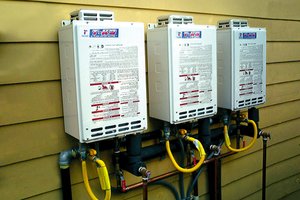There’s a relatively new alternative to the standard water heater tank that you probably have in your utility room. Rather than keeping gallons of water hot and at the ready at all times, these tankless, or “on-demand,” units kick on only when you open the hot-water tap. Then they heat the water instantaneously as it flows, providing you with an endless supply and saving you $100 or more a year in energy costs.
How a tankless unit works
An on-demand system makes hot water only when you need it, explains Millbrook, N.Y., architect Chris Colby, who designs energy efficient houses. When you turn on the shower, for example, water begins flowing through capillary-like pipes in the heater that are surrounded by a powerful gas burner—or electric coils in the case of electrical systems—where it’s heated on the spot. (There are no oil-fired on-demand water heaters on the market.)
As a result, a tankless water heater never runs out of hot water. With a traditional tank, once you use up the ready supply inside, you have to wait for the heater to make more, a process that takes at least 20 minutes, depending on your model. Because an on-demand system heats water as you use it, as long as it has water and fuel, you’ll have hot water.
More importantly, since on-demand units fire only when needed, they’re very efficient. For a typical house, on-demand hot water slashes hot water energy bills by a quarter to a third.
Limits on simultaneous uses
Though on-demand units can keep pumping out hot water all day, they can’t produce a big quantity all at once. With a traditional tank heater, you can shower, run the dishwasher, and do a load of laundry all at the same time. But an on-demand heater can’t handle that much volume and would therefore provide only a trickle to each simultaneous user.
The typical on-demand unit puts out 2.5 gallons per minute (gpm). Top-of-the-line models can put out 5 gpm, enough to handle two uses at the same time, but not the 7.1 gpm required to run the shower, dishwasher, and clothes washer all at once.
When you’re comparing flow rates, pay attention to the rise in temperature being quoted. Energy Star measures gpm based a 77-degree increase in water temperature for the incoming supply, but some companies list their gpm flows at 35- and 45-degree rises. The more heating the water requires to reach the desired temperature, the slower the flow rate.
Installing multiple units
One solution to the limited output problem is to install multiple on-demand units. Because they’re small—about the size of a carry-on suitcase—they can be placed just about anywhere your water line runs: attic, basement, closet, or crawlspace. So you can have two or three units serving different parts of the house, and plenty of hot water.
Having multiple on-demand units won’t reduce your overall household energy efficiency. In fact, it does just the opposite. By bringing the hot water close to where it’s needed, you reduce the energy loss of piping heated water through the cold basement and walls and increase efficiency a full 50% over a standard hot water tank system, about $165 in annual savings for an average household.
High upfront costs
The downside to installing multiple on-demand water heaters is that even one of these systems is quite costly. A gas-fired unit will run you $1,500 to buy and install, nearly double the price of a standard gas water heater, and $575 more than a high-efficiency tank model. And the costs can go up from there: While tank water heaters typically use a half-inch gas line, on-demand units need three-quarter-inch pipe. Making that change costs from $25 to $40 a foot, so if you’re putting one or more units near the kitchen or upstairs bathrooms, you can add many hundreds to the initial costs.
On the bright side, if your unit has an Energy Factor of .82 or higher, as many do, you can get a 30% federal tax credit up to $1,500 on purchase and installation costs incurred in 2010. Electric on-demand units cost less, as little as $400 installed. But they don’t qualify for tax credits because they’re less efficient than gas and are better suited for point-of-use applications, such as instant kitchen hot water, rather than a whole-house system, according to Potomac, Md., contractor Jay Irwin.
The bottom line is that unless you’re going to invest big bucks in a several on-demand water heaters, these systems work best for small households without a lot of simultaneous hot water needs. For a large family living in a big house, a high-efficiency traditional tank unit still may be a better option.
Joe Bousquin HoseLogic.com June 8, 2010

No comments:
Post a Comment